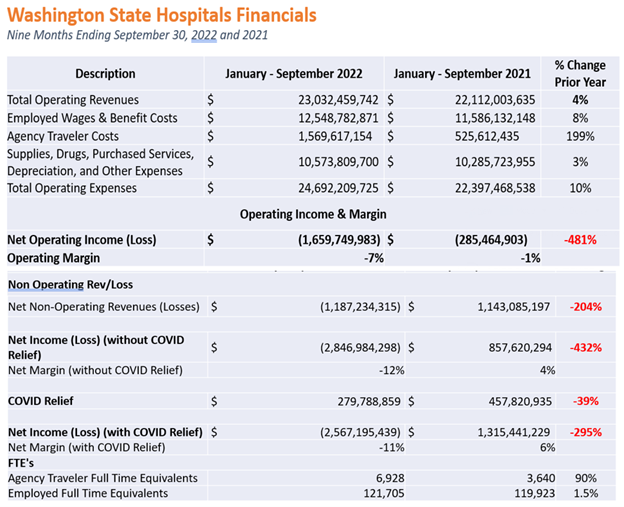Survey results released this week from the Washington State Hospital Association (WSHA) show total hospital and health systems losses grew to $2.57 billion in the first nine months of 2022 with almost $1.66 billion of this loss from operations.
“These ongoing, unsustainable losses are beginning to impact patient access to services,” WSHA CEO Cassie Sauer said. “Hospitals are beginning to cut some services to preserve vital lifesaving care. If this troubling trend continues, some hospitals will need to seek partners to remain open or consider closing their doors if no options are available.”
WSHA surveyed all acute care hospitals in Washington to compare their nine-month financial results from Sept. 30, 2021, to Sept. 30, 2022. This survey represents all hospital systems and almost 98% of hospital beds across the state. Hospitals included in the survey employ more than 121,000 people. This is the third quarterly survey conducted by the association. Key findings include:
- While revenue was up 4% year over year, total operating expenses increased by 10% in the first nine months of 2022 compared to the same period the prior year. Higher expenses were driven by significantly increasing costs for staff, energy, supplies and drugs.
- Employee compensation increased 8% during the first nine months of 2022 compared to the prior year. Hospitals have hired about 1,800 full-time employees (FTEs) since Q2 as the number of hospital employees increased by 1.5% to more than 121,000 full-time equivalent positions.
- Net operating losses were $1.66 billion for the first nine months of 2022, which represents a negative 7% margin. In 2021 the net operating losses were $285 million.
These losses mean many hospitals are spending down reserves that would typically be used to invest in new technology, service lines, physical plant upgrades and paying down long-term debt.
“If current trends continue, about half of Washington’s hospitals will be out of money by the end of 2023,” WSHA’s Chief Financial Officer Eric Lewis said. “Hospitals are considering bed and service closures as a way to preserve resources for the most critical services.”
During a media briefing this week hospital leaders shared impacts of the shortfalls on patient care, including the closure of cardiac services at Astria Health in Sunnyside.
There are a number of factors contributing to financial distress. Reasons include underfunding of Medicaid, higher costs for staff, supplies, and medications, and patients who no longer need hospital services who are taking up beds with either no payments or significantly limited payments to cover the cost of their care.
Hospitals are asking for several actions from the Washington state Legislature to address these issues in the long and short term, including:
- Increase Medicaid payment rates for hospitals. The Medicaid payment rate for most hospitals has not increase in 20 years. WSHA’s proposal will maximize federal funding and bring hospital Medicaid payments to at least Medicare levels – about 76% percent of the cost of providing care.
- Increase payments for long-term care to ensure the chronically underfunded long-term care system can attract and retain staff. The most complex patients can remain in hospitals for months awaiting placement in a long-term care facility. We need solutions to address this issue.
- Improve process used to for Medicaid patients in need of guardianship to expedite discharge to appropriate long term care settings. DSHS interpretation of federal and state law has led to a significant increase in patients in hospitals who must have a court appointed guardian to move out of the hospitals and into long-term care placement. WSHA supports allowing a court to order, as part of guardianship proceeding, appropriate hospital discharge and long-term care placement for an individual in a hospital.
- Develop and fund new behavioral health 23-hour crisis receiving centers. Currently, Washington state has very few options for people experiencing a behavioral health crisis besides the emergency department. WSHA supports the development of a sustainable funding model and recognition in law for a new type of facility that will function as an alternative to the emergency department for people experiencing a behavioral health crisis.
- Continue to allow staffing flexibilities as hospitals deal with high demands for emergency and other routine and life-saving care. The pandemic has shown us that delaying care leads to sicker patients who stay in hospitals longer, which further strains staffing.



